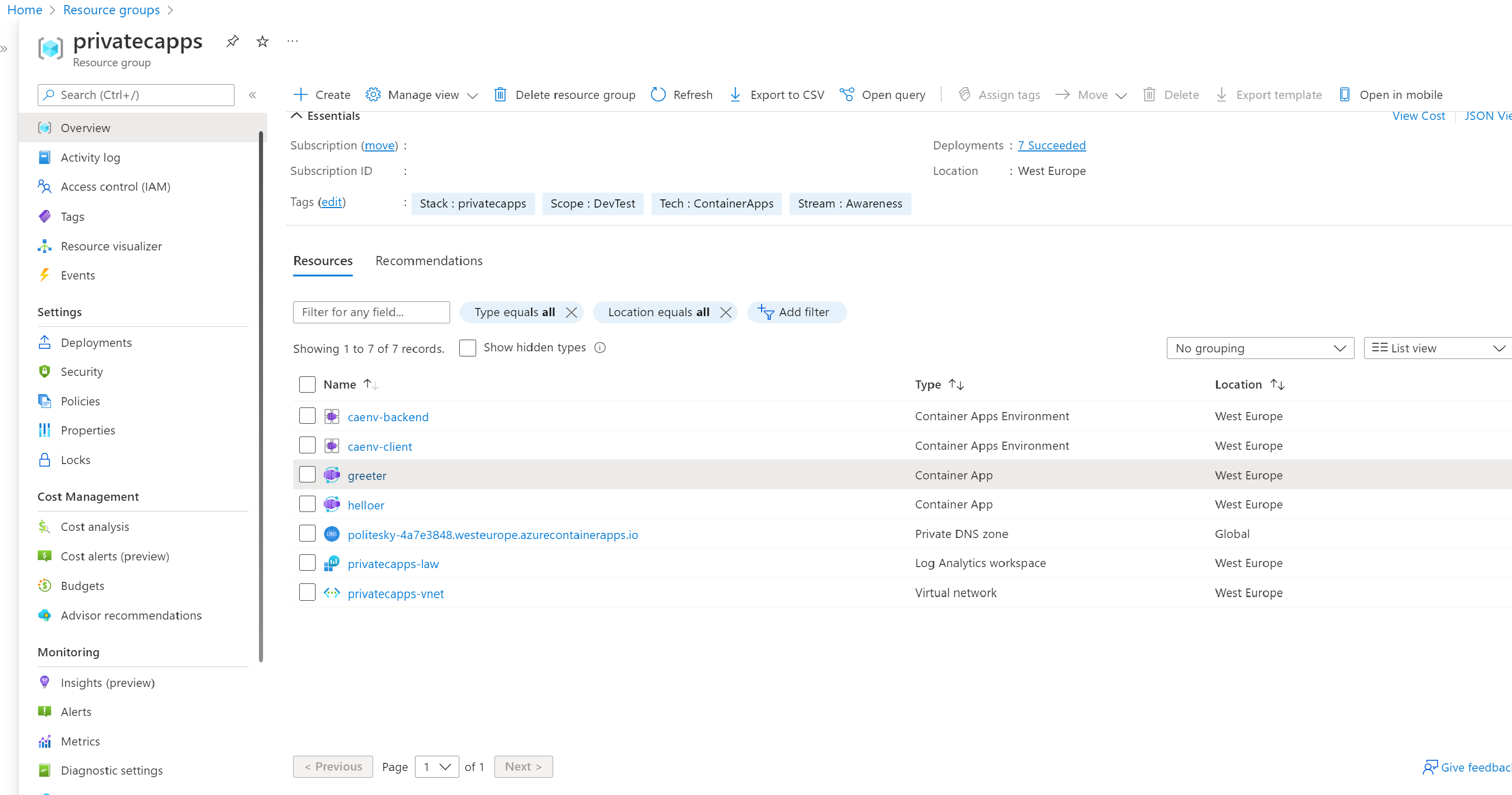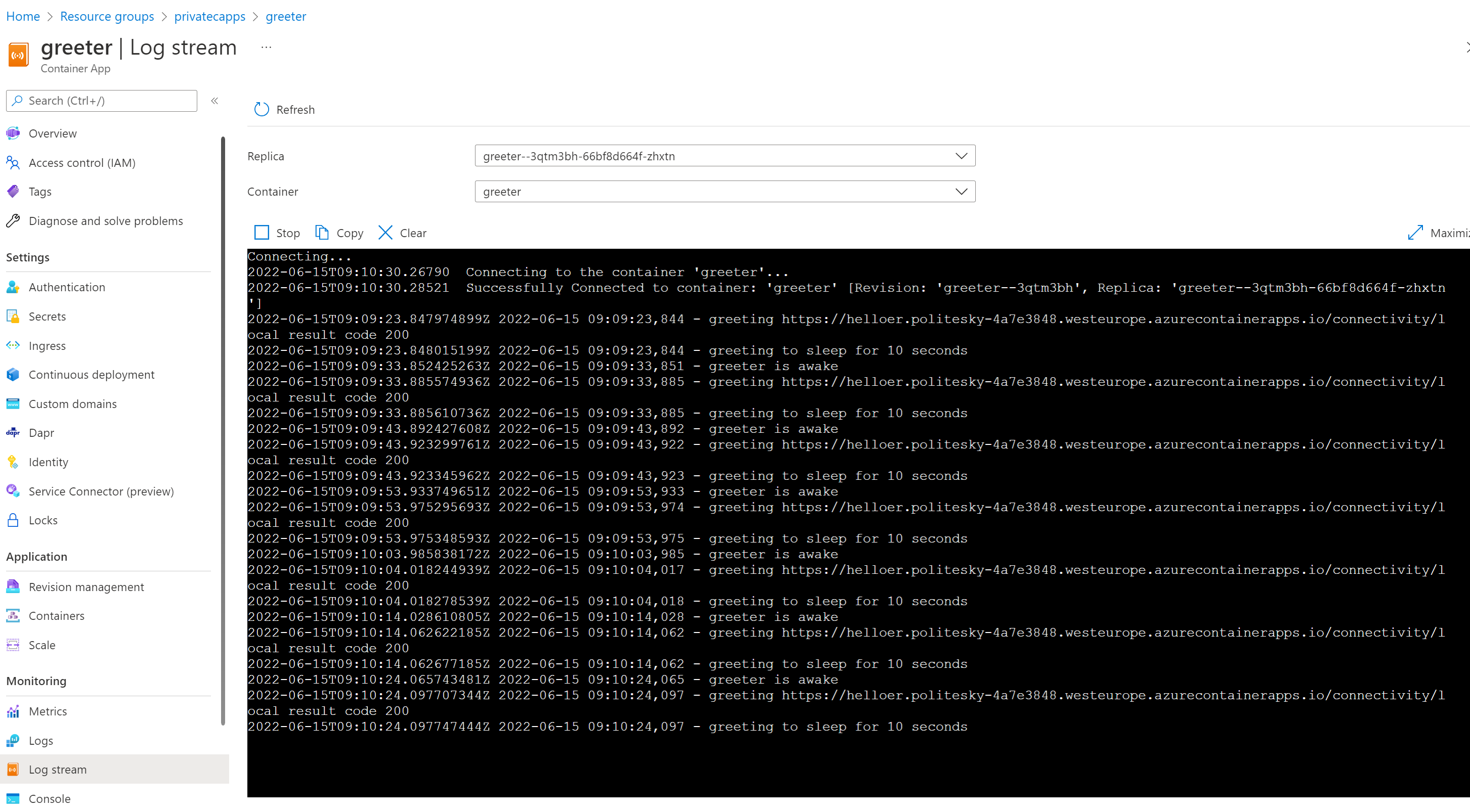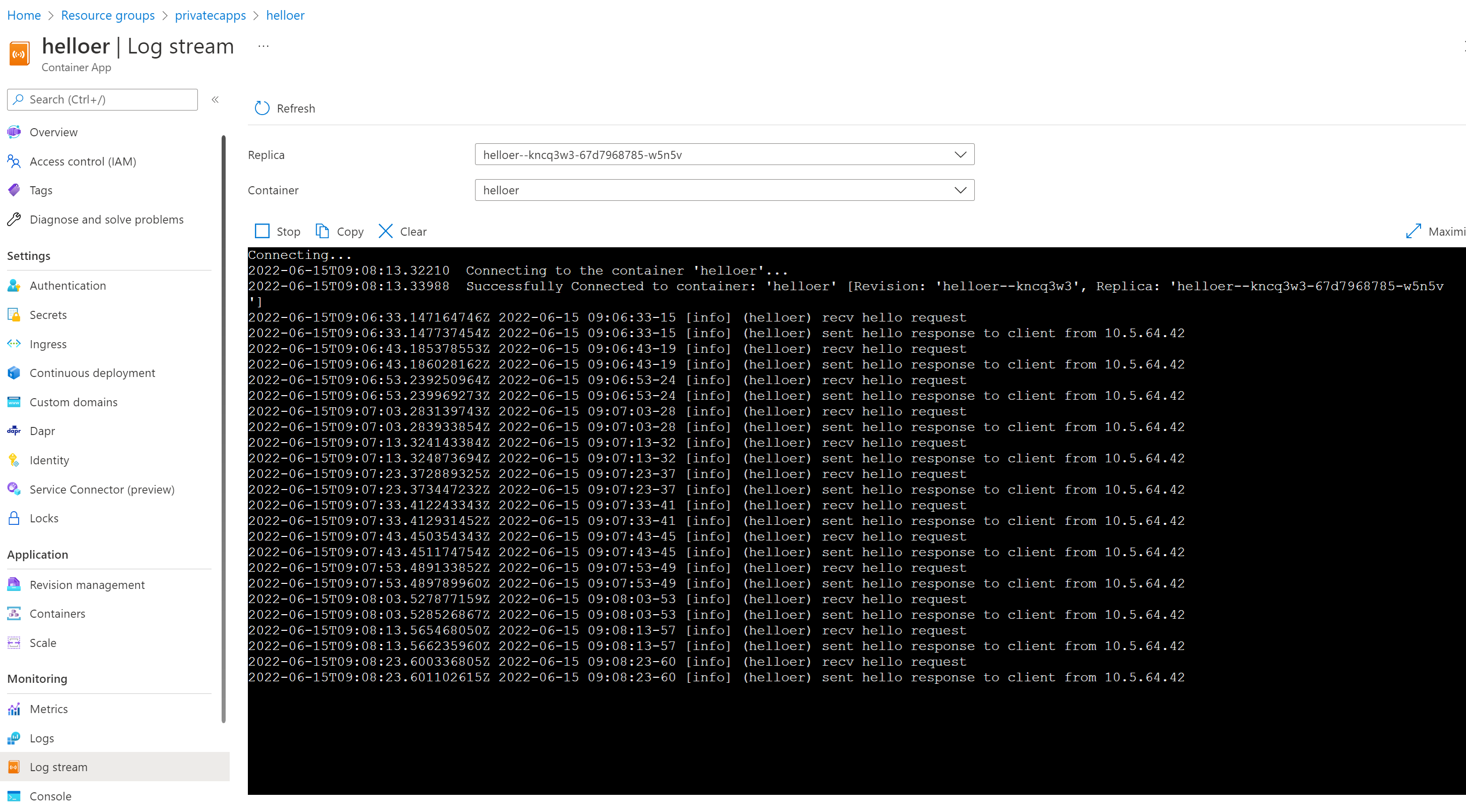The Azure Container Apps is a new and quite interesting Azure service providing a fully managed, ready to roll, serverless environment for your containerized applications.
By providing a fully managed solution the ACA removes all the operational dependencies on the Kubernetes (skills, learning curve, dedicated infra team) and let you focus on the essential, i.e your applications!
This service provides huge added value when it comes to developing cloud native applications or accelerating your application modernization process.
And as the ACA provides both public and fully private VNet connectivity if can fit pretty much any of the Enterprise contexts where the need for private traffic flows is a mandatory requirement.
This repo demonstrates the deployment of a set of applications in a fully private mode where all the traffic flows through your Azure Vnets.
Due to the freshness of the service GA, the IaC framework coverage for Azure Container Apps is quite limited. You can only use Azure ARM, CLI or Bicep to automate the deployment.
The current repo provides the Bicep implementation and will be updated when additional frameworks (Terraform and eventually Pulumi) will extend their coverage in order to provide the bindings for this service.
The demonstrator deploys two Container Apps communicating via private connectivity over your VNet infrastructure.
The following diagram provides a high level overview of the demonstrator:
The caenv-backend environment hosts the helloer application, a simple nodejs app that responds to http requests.
The environment is injected in a specific subnet and connected to the privatecapps-law Log Analytics workspace in order to provide diagnostic settings and log centralization.
The application exposes an ingress via the environment ingress static IP. In order to reach your application ingress, the caller application must use the ingress FQDN as detailed in the following doc .
Note that hitting the ILB behind the ingress with the IP address will not work as the hostname is used to route the traffic to the correct application within the environment.
Hence we need to set up a private DNS zone with a wildcard ('*') A record pointing to the environment ingress static IP. The wildcard is justified by the fact that a given environment can have several applications, each with its own ingress, served from the same Internal Load Balancer.
The final app flow routing will use the hostname which is expected to be the same as the application name (in our case helloer.envSystemName.region.azurecontaierapps.io ).
The caenv-client environment hosts the greeter application, a tiny python script that performs periodical HTTP GET requests to the backend.
The environment is injected in a specific subnet and connected to the same privatecapps-law Log Analytics workspace to provide diagnostic settings and log centralization.
This Greeter application does not provide any ingress, so there is no need to set up a DNS zone for this environment.
The source code tree is classic, the main.bicep provides the definitions of the demonstrator and relies on specific modules to deploy the underlying infrastructure services.
The network infrastructure is defined in main.bicep. If necessary update the ranges in order to fit your Azure environment constraints.
The implementation of the VNet and underlying subnets is performed by the dedicated vnet.bicep module.
The network module outputs the identifiers of the created Vnet as well as of the subnets that will be required to wire up the VNet injection and the DNS zone.
The Azure Key Vault is used to avoid sharing secrets between the biceps modules and has no incidence not usage in the demonstrator runtime. It's life cycle is the deployment process, so the KV is not configured to support the “soft delete” and can be safely removed on each environment cleanup.
In this demonstrator a single Log Analytics Workspace centralized all system and application logs related to the two application environments. You can use the KQL language to perform fine gran level queries to observe and troubleshoot your apps. You can also use it as a base for building monitoring and health dashboards.
The LAW is deployed by the law.bicep module. Note that the client shared key, a sensitive info, is stored directly in the KV and never stored on the deployment trace level.
The container apps environments are implemented in the caenv.bicep.
The vnet injection is set up by providing the adequate subnet id to the environment module as illustrated in the main.bicep for the caenv-backend. A similar assignation is provided for the caenv-client environment at main.bicep. The identifiers of the
The environment is attached to the Log Analytics workspace by setting up the log analytics clientid while the shared key is fetched from the KV before being injected in the environment via a secure param.
In order to set up the DNS zone we'll need the VNet Id, the environment domain as well as the environment static IP assigned on creation time.
The domain name is provided by the backend service application environment as an output of the dedicated env module, assigned from main.bicep and used in the dedicated caenvdns.bicep module.
The static Ip is used to set up the wildcard A record in, assigned from main.bicep and used in caenvdns.bicep.
The VNet is provided as the output of the vnet.bicep module, assigned from main.bicep and used in the caenvdns.bicep module.
The Container Apps are defined in main.bicep and realized by the dedicated ca.bicep module.
The helloer application ingress definition can be found in main.bicep while the greeter has no ingress.
The greeter application requires the URL to hit to be provided as a GREETER_URL environment variable. The value of the url is computed at main.bicep and assigned at main.bicep
In order to deploy the demo project you'll need the following dependencies:
- Azure CLI
- Azure CLI Bicep extension
- GNU Make
- GitHub project clone
We advise using a Linux shell or WSL on Windows as it was used to build the project. However, any OS with the dependencies installed will work as well.
If you have trouble installing GNU Make (i.e you are probably using a Windows shell), you can simply type the commands referenced in the Makefile for each rule. Just make sure to remove the @ prefix from each command line.
Start by connecting to azure from the command line:
az loginTo deploy the project with default values for the resource group name and region simply issue the following commands:
cd src/bicep
makeIf you want to customize the location or the resource group name you can use the following:
cd src/bicep
make stackName=<myRGName> location=<myAzureRegion>The scope of the bicep project is the subscription and therefore requires the user to have the necessary privileges on the subscription level.
If you are not in that situation, then you it should be possible to deploy it on a resource group level by :
- changing the targetScope to 'resourceGroup' in the main.bicep
- commenting the resource group creation from main.bicep
- changing the command lines in the Makefile to deploy on an existing resource with the help of this doc
Once the deployment process is finished, start by taking a tour on the created resource group and you should see an output similar to the following :
Then take a look at the Log Stream of the Greeter application, that should look similar to the following :
Then take a look at the Log Stream of the Helloer application, that should look similar to this :
Note the trace showing the calls :
2022-06-15 15:55:01-07 [info] (helloer) recv hello request
2022-06-15 15:55:01-13 [info] (helloer) sent hello response to client from 10.5.64.42It indicates the request is addressed from a client with IP 10.5.64.42, i.e. the request origins from the subnet-caenv-infra-client (10.5.64.0/20) where the caenv-client has been injected. So the application flow is fully private and both source and destination subnets are clearly identified and isolated, allowing to leverage various security related services to enforce the flow security.
Additional insights on your apps and infra can be found from the log analytics workspace.
In order to check system logs, go to the Logs entry of any of the applications and explore the available events by entering the simplest possible KQL query :
ContainerAppSystemLogs_CL In order to check and explore the applications logs, which you already looked at using the Log Stream, go to the Log Stream entry of any of the application and explore the available events by the simplest possible KQL query :
ContainerAppConsoleLogs_CL You can then refine both queries using the KQL language
The Metrics tab will scope Azure Monitor to your application to provide a quick way of building your application monitoring dashboards.
And if you're interested by the underlying infrastructure implementation, take a look at your VNet and check the Connected devices entry of the created VNet, you'll see the injected Kubernetes nodes and ILBs, which can give you an idea on how the service is built. Also look at the resource groups that start follow the MC__ pattern. They are created on Container App environment time and contain dedicated resources for each of the injected container environment.
To delete all the deployed resources simply issue the following commands :
cd src/bicep
make cleanIf you have customized the resource group name, then please make sure it is provided as a parameter :
cd src/bicep
make stackName=<myRGName> cleanAt the current stage this repo demonstrates a simple setup and focuses on the network connectivity.
Ideally we'd like to cover the following areas as well:
- Network filtering with azure firewall
- Hybrid public/private connectivity
- Usage of managed identities to access azure services
If you're interested in contributing in any of the above mentioned areas, please reach out !



